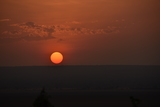
We left the lakeside lodge and started driving toward the other national parks.
18 October 2017 Wednesday - Water filters, Maasai village ~ Day 9
Today was another very busy day in Tanzania. Instead of viewing animals on a game drive, we spent the whole day doing cultural things. It started out with another glorious sunrise over the dry lake at the lodge.

We
left the lakeside lodge and started driving toward the other national
parks.
Our first stop was a nearby well used by local villagers to get water. The well was just a big hole in the ground. Women took buckets on a long rope, lowered them into the hole, and came up with water.
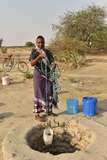
One
of the women had a cute baby on her back.
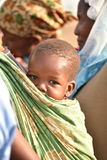
The
well was very deep. I set my camera on a very high ISO so I could
take a photo all the way to the bottom. It shows how dirty and muddy
it was, especially exposed to the open air where things like dust,
dirt, and bird poop could drop inside.
A few of us, including Kathy, tried our luck at fetching water from the well. It was slow, tedious, and often the buckets came up with only an inch or two of water at the bottom.
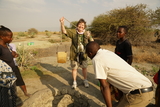
In
my travelogue from a few days ago, I mentioned that we had stopped at
a shop that manufactured ceramic water filters to make well water
safe to drink. Now was our time to give those filters away to
ordinary families who needed them.
A few women had gathered at the well to collect water for their families. Eki chose four women at random, explained the water filters, and presented the filters to them. There was a fifth woman who didn’t get a filter and she was unhappy and jealous about it. The women who got filters seemed very happy. One woman was almost in tears.
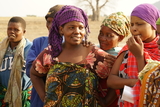
Eki
spent a very long time explaining how to wash and take care of the
filters. The women listened very carefully.
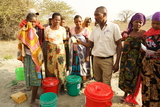
The
women seemed very grateful and happy for the gifts.
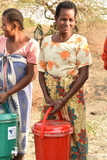
I
took a photo of Kathy with one of the women: hopefully, we had
changed her life for the better. Thanks to the filter we gave her,
her family could now drink clean water and her children would not get
sick from it.
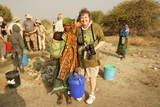
Kathy
took my photo with her too.

We
drove through the African countryside for a long time. There wasn’t
much to see. Just an occasional mud hut.
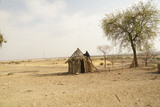
Finally,
we arrived at a traditional Maasai family compound.
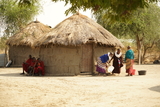
We
were greeted with lots of singing and dancing.
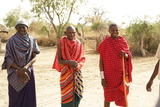
The
kids hanging around were cute.
Like all Maasai compounds, it had a herd of cattle. One of the cows had a newborn baby. It had been born that morning, and we could see some of its umbilical cord still attached. The mother was licking and cleaning it. It was so cute.
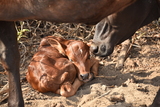
Many
years ago, I saw a television show about the Maasai people. They were
portrayed as a small tribe, living in such remote, harsh conditions
that they had to survive by drinking the blood of the cattle. There
may have been some truth to this, especially in the past.
Now there are millions of them and they’re not in such dire conditions, but they still keep their traditions alive. It turns out that they do drink a mixture of blood and milk. They decided to show us how they extract blood from a cow for drinking. It was hard to watch.
First they captured one of their many cows. They put a rope around its neck to act as a tourniquet. One man held the cow’s head with his hands. Another man held it by the tail. The clan elder strung his traditional bow.
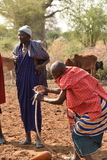
He
readied an arrow that had a small razor sharp tip.

He
pointed the arrow at the poor cow’s neck at a short distance and
expertly fired it, just grazing the cow’s neck. In an instant, the
arrow sliced the cow’s artery open with great precision, and blood
came spurting out.
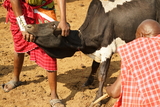
The
Maasai put their gourd—which already had some milk in it—up to
the cow’s neck to catch the stream of blood.
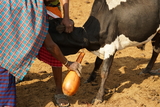
They
didn’t take much of the cow’s blood. Just a little. Then the
elder pinched the cow’s wound to stop the flow of blood.
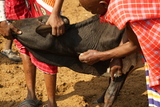
Then
he took off the tourniquet, dressed the wound and put some of the
dried sawdust on it.
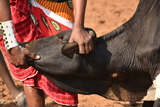
Then
they let the cow go, and she seemed just fine. He offered us a taste
of the blood-milk mixture, but everyone in the group turned him down.
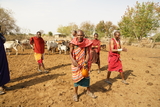
He
took a big drink and seemed satisfied with the result.
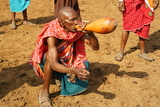
Eki
took the flask and poured some of the blood-milk-mixture into the cap
and showed us the drink up close.
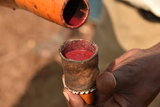
Next,
the Maasai decided to show us the traditional way they used to start
fires in the olden days. They put one of their large machete-like
knives on the ground and crossed it with a small piece of wood that
had a small hole started. One man held the stick in place. Another
man inserted a second stick into the hole.
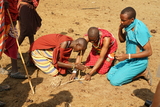
One
of the able-bodied men started rapidly rotating the stick back and
forth between the two palms of his hands.
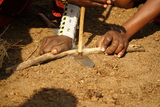
Eventually
the wood got hot and started to smoke, as some sawdust crumbled away.
The man eventually got tired and a second man stepped in and took
over. He was quick enough that the wood didn’t cool off.
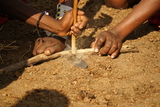
The
sawdust that had broke free started smoldering, and they dumped the
sawdust onto the knife.
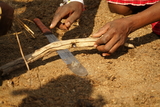
The
clan elder picked up the knife, with the smoking sawdust on it. He
dumped it onto a pile of straw in his bare hands.
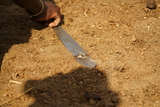
Then
the elder started blowing very carefully on the smoking sawdust and
straw.
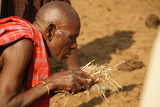
Then
poof—the straw erupted into flames, in his hands.
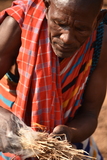
He
carefully set the flaming pile on the ground and they added some
twigs. The demonstration was complete. They had started a fire with
just two pieces of wood, and a machete.
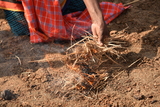
Next,
the villagers demonstrated some of their traditional dancing while
the kids stood around and watched.
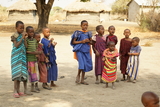
First,
the women did a very lively dance.
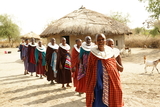
They
got women from our group to dance, and even Kathy got involved. She
had a good time.
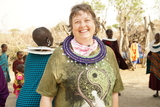
You
could see that many of the people were missing a few of their bottom
teeth. This is another one of those Maasai traditions George (our
Masai Mara guide) explained to us. The teeth are pulled. Today it’s
tradition. But it is rooted in the thought that if a person gets
sick, they can administer food and medicine, even if their mouths are
closed.
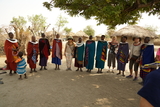
Maasai
children just watched all the singing and dancing of the adults. They
were content to just lie in the dirt and watch.
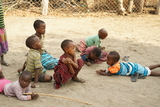
Next,
the men from the village did a traditional Maasai dance, wearing
their traditional garb.
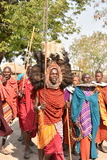
Wait
a minute. That guy’s not taller than the rest. He’s just doing
that jumping dance again.
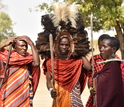
At
times, the song seemed solemn, but it was in their language, so of
course we couldn’t understand what they were singing.
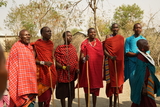
Some
of the women let Kathy and the other women from our group try on
their decorations.

They
were taught how to carry things on their heads. For some reason, they
decided not to try it with Kathy, but she was given the ceremonial
gourd to carry in a procession.
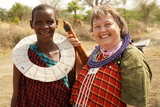
The
little girls got involved in the celebration too. They were
practicing their head-balancing too.
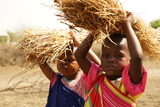
Next,
the villagers showed us how the huts were constructed. They let some
of us plaster the outside walls with a combination of mud and cow
manure. Kathy had to try it herself, but she wisely brought plastic
gloves.
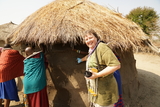
Then
they showed us how the grass roofs were constructed.
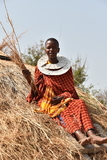
One
of our group, Judy, decided to get up on the roof so she could try
her hand at it.
I asked to take a photo of Kathy with some of the gentlemen of the clan, including the elder.
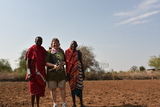
After
that, the women gave us another demonstration of their traditional
dancing.
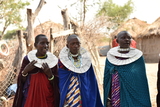
Some
of these dances involved jumping up in the air. Kathy took some
photos during the dance, and it makes it look like they were
levitating.
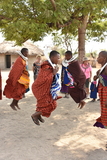
The
kids hanging around were very cute. Kathy took this photo of one of
the girls.
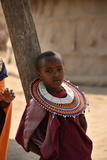
Then
she asked her to smile. So cute.
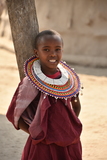
Even
when they were unhappy, they were cute.
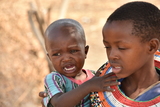
Next,
we went into the elder’s first wife’s home. There we got a short
talk about home life and we got to ask some embarrassing questions.
One of our group asked the elder how he indicates which wife he wants
to sleep with and how he gets her attention. He basically said it’s
his secret.
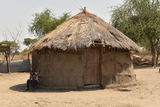
Their
master bedroom was actually decent size, and had cowhide blankets to
stay warm.
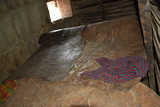
Before
we left, a group of women laid out things we could buy. We’re not
really into African art much, but Kathy found some fabric she can use
for quilting. She bargained with the woman for a long time. She had
fun.
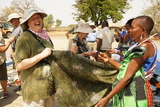
Next,
we drove to a local school not far from the Maasai compound we had
left. At first, the school seemed empty and abandoned. We were told
that we had the misfortune of having come on National Examination
Day, when all the school kids were taking a national skills test. So
all the kids were gone.
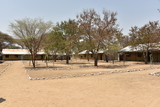
The
school principal was a stern and professional woman. Her English
wasn’t that great, but you could tell she was serious. She started
to give us a talk about schools in the area. After about a minute, we
decided it was way too hot to stay in the school room. So we all went
out, walked across the school courtyard, and settled into a different
room that was a little bit cooler, and had a breeze.
The principal was proud of how many children they taught, and the percentage of kids who passed the national competency tests for the past five years. We asked them some questions. For example, we found out that there is absolutely no distinction for the different tribes in Tanzania: At the school, every child is considered equal and none are given any special considerations. So the Maasai children were no different from children of other tribes. They all wear the same uniform, (different ones for different grades or classes or something). As a matter of fact, it was almost impossible for me to tell the girls from the boys. It seemed like the boys wore skirts, and the girls all had shaved hair.
After the principal’s lecture, everyone in the group presented her with gifts for the children. Some of us brought practical gifts like paper and pens. Others brought toys. Kathy and I brought some colored gel-pens, but the principal didn’t seem to like them. She sternly said that they did all the work with black pens. Someone in the group brought a soccer ball, which we inflated.
Soon after that, we heard lots of noise. The children must have finished up their testing, because they started filling the schoolyard outside. We went outside to greet them and they were very fun.
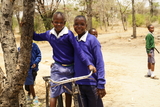
The
kids immediately started playing with the soccer ball and the
Frisbees someone had brought.
The kids loved it when we took their photo, then displayed the photo on the camera. Some of them made funny faces for the camera. Others were more serious.
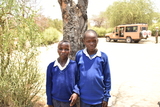
Next,
the principal took us to the kitchen. One of the reasons parents like
to bring their children to school is because they’re all given a
good healthy meal. Today, a man in the kitchen was cooking a huge vat
of baked beans and lentils.
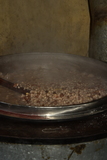
There
was also a large chicken coup and they had collected about two dozen
eggs for lunch.
When we got back in the bus, all the kids waved goodbye. So cute.
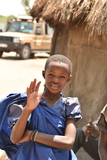
Next,
we drove to a shop where they hand-carved African art, like animals,
from pieces of wood.
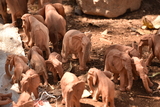
They
were beautiful. Some of it was ebony wood. They showed us how they
did it, and the tools and materials they used.
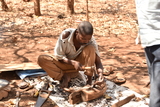
Kathy
and I weren’t going to buy anything, but then we asked about a
price for a really cool hand-made ebony carving of a pod of hippos.
We kind of fell in love with it, but it was way too expensive.
Finally, I did some really hard bargaining, and we went home with it.
Kathy couldn’t believe what a good deal I got with my bargaining.
She kept remarking how she didn’t know I had it in me to bargain
that well. What I really did was tell them the price I wanted to pay,
which was considerably less than half their asking price. Eventually
I worked my way up in very small increments, and got a very good
deal.
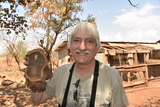
We
stopped and ate lunch where we discovered a new delight: Here in
Tanzania, they have a (non-alcoholic) ginger beer here called Stoney.
It’s like ginger ale, only better. Kathy and I buy ginger beer from
Costco called Bundeberg, but Stoney was way better than that. I wish
they had it back home! The bottle said it was a product of the Coca
cola company, and bottled in Tanzania.
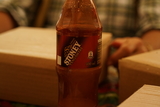
We
ended our day at another very beautiful lodge. A marabou stork hung
around outside the dining hall to see if anyone would give him
scraps. We didn’t. But he was very patient and unafraid.
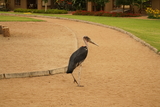
All
of the rooms had beautiful flowers outside, and a beautiful view of
the valley. Well, almost all the rooms. They gave us a room at the
very end of the line. It had no flowers and no view, and took us a
long time to walk there. Kathy was unhappy and let Eki know it.

Our
room was nice, and as usual, had mosquito netting around the bed.
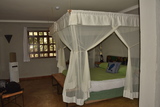
Tomorrow
we’re supposed to have a brief stop at the top of the Ngorongoro
crater, then we’re driving to the Serengeti camp. We’ll see the
crater several days from now on the way back to Arusha.